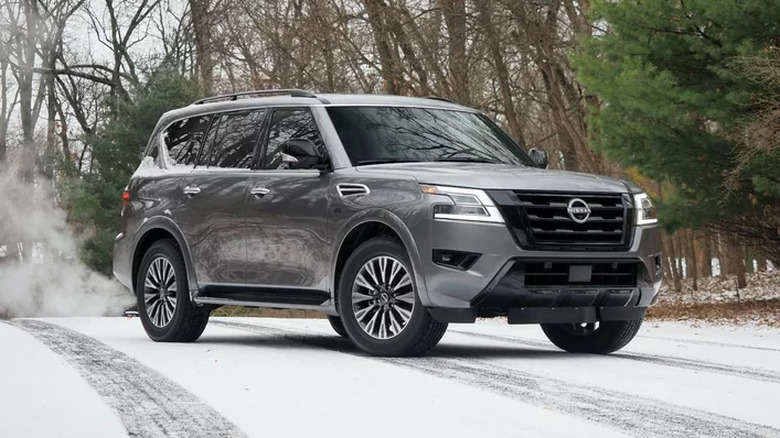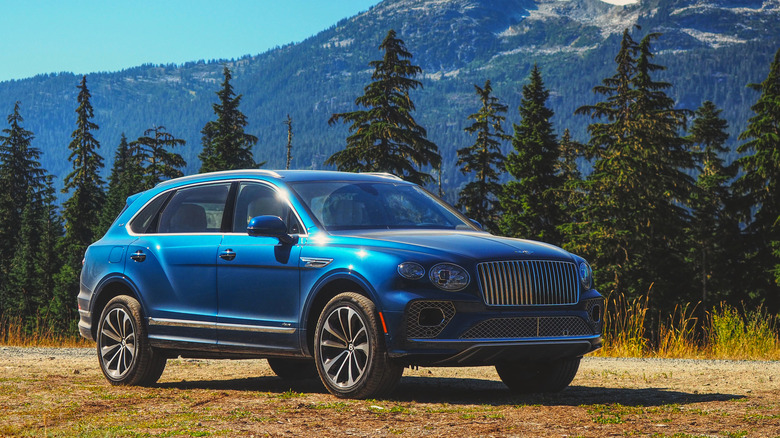How Big Is The 2023 Toyota Sequoia?
Make no mistake, no three-row SUV is going to be small. Unlike the TARDIS in "Doctor Who," the laws of physics can't be upended: if you want usable seats across all rows, then there's going to be some compromise in external dimensions. That said, some SUVs are better there than others.
The 2023 Toyota Sequoia stands out in the SUV category for a number of reasons. Completely new for the 2023 model year, it ditches the old model's thirsty V8 in favor of a gas-electric hybrid drivetrain, while the dashboard gets a comprehensive upgrade with a welcome introduction of new tech.
In the parking lot, meanwhile, it measures 208.1 inches long, and 79.8 inches wide. That sounds a lot — and, at more than 17 feet in length, it is — but in the grand scheme of the category, it's actually one of the smaller three-row SUVs. Here's how it compares.
Three-row SUVs are generally large
The full-size SUV segment has some serious whales, and if you're concerned about squeezing into a parking space then it pays to know the measurements as you're putting together a shopping list. Of the main competitors, Nissan's 2023 Armada actually comes close to the Sequoia in length: refreshed for the 2021 model year, it's less than an inch longer than the Toyota, at 208.9 inches, and a tenth of an inch wider.
They're the exception, though, not the norm. Over at Ford, the 2023 Expedition measures 210 inches in length and 79.9 inches wide in its standard form. The 2023 Expedition MAX — which stretches even longer for more cabin space — is 221.9 inches long.
It's a similar story at Chevrolet's showroom. The 2023 Tahoe is 210.7 inches in length and 81 inches wide, so very slightly bigger than the Expedition. The 2023 Suburban, meanwhile, stretches to 225 inches in length: more than a foot longer than the Sequoia.
The true SUV behemoths make the Toyota look small
They're big numbers, but they're not even the biggest in the segment. Stroll into a Jeep dealership, and the 2023 Wagoneer and Grand Wagoneer have an even beefier footprint. Both the Wagoneer and the Grand Wagoneer measure 214.7 inches in length and are 83.6 inches wide.
The Wagoneer L and Grand Wagoneer L — Jeep's stretched versions of the SUV — are even bigger than the Suburban. They're 226.7 inches, making them about a foot and a half longer than the Toyota. You see some of the benefits of that if you're in the third row, mind, which has three inches more legroom than the Sequoia offers.
Then there's Cadillac's Escalade, hardly a coy SUV. While Caddy may have toned down the exterior styling for the latest generation of Escalade, it's still a hefty vehicle. In standard form, the 2023 Escalade measures 211.9 inches in length, and 81.1 inches wide, but in the 2023 Escalade ESV form it's a whopping 227 inches long.
Turning radius arguably makes a bigger difference
While the length and width of a vehicle have a big impact on things like parking or squeezing down narrow urban streets, there's another factor to consider. The turning radius, or the turning circle, of an SUV — how much space it requires to make a semi-circular U-turn — is arguably just as important.
The tightness of the turning radius makes itself known when you're cranking the steering wheel to maneuver your vehicle. Think about trying to turn in the road and head back in the opposite direction: a smaller turning radius could mean the difference between making it in one sweep, or having to shift between drive and reverse to avoid going off the edge of the asphalt. Interestingly, overall SUV size doesn't necessarily correlate with turning radius. The 2023 Sequoia needs 20.1 feet — though the TRD Pro trim is an outlier, extending that to 22.3 feet — while the Armada demands 20.65 feet. However, some of the larger vehicles can actually turn more sharply.
Jeep's Wagoneer, for example, requires 19 feet, while the longer Wagoneer L requires 21.1 feet. The Escalade is another unusually nimble behemoth, needing 19.85 feet in standard form, or 21.65 feet for the Escalade ESV. That's the same as the Chevrolet Tahoe and Suburban — which use the same underlying platform as the Caddy — while the Ford Expedition demands 20.5 feet and the Expedition MAX needs 21.65 feet.
The fix to big, unwieldy SUVs is out there
A solution to overly large turning circles is out there — it just requires some familiar tech from luxury vehicles to make it down into more mainstream models. Rear-axle steering sees the back wheels pivot just as the front wheels do when the steering wheel is turned, though the direction in which that happens depends on how the vehicle is being driven. At high speeds, the front and rear axles are synchronized, turning in the same direction (albeit typically at different degrees, with the rear axles generally topping out at 10 degrees at most). That allows the vehicle to make lane changes with more stability.
At lower speeds, though, the rear axles pivot in the opposite direction. That effectively shortens the wheelbase of the vehicle, reducing the distance required to turn it. We've seen that pay dividends for big luxury sedans, like the Mercedes S-Class, and it's also increasingly being included in luxury SUVs like the Bentley Bentayga EWB. While it's never going to make them feel as maneuverable as a Smart car, it can leave a big sedan feeling as nimble as a vehicle from the size class below.
Rear-wheel steering isn't common on three-row SUVs yet, but that seems only like a matter of time. As the appetite for large vehicles capacious for both passengers and cargo continues to grow, the need to make such behemoths more driver-friendly will only increase too.




